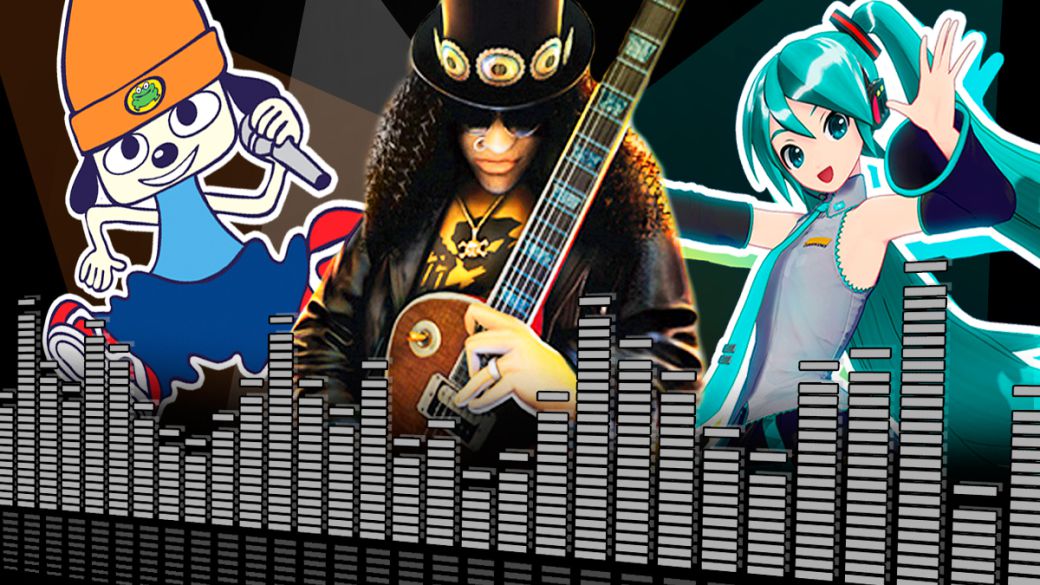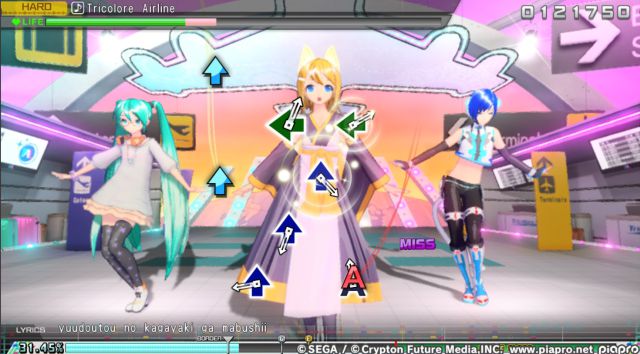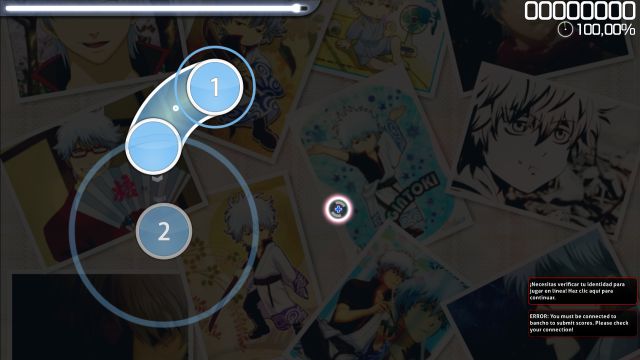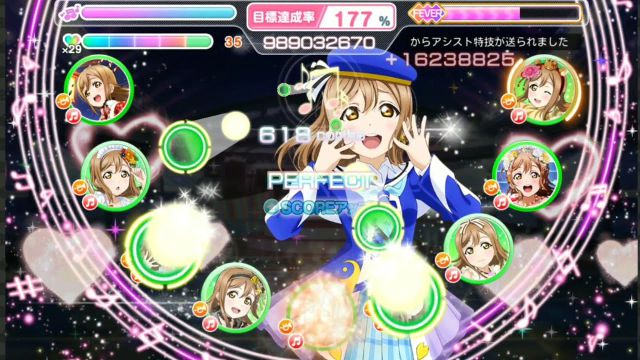
We review the history and development of rhythm games, its origins with Parappa the Rapper until today on mobile devices
Getting at the controls and noticing how the fingers flow on their own making combinations of buttons that at first glance seem impossible for humans is one of the best sensations that rhythm games can generate. It is a genre of the most varied in terms of controls and content, which has been with us for decades and has a special place among the hobbies of many players. Recently, Kingom Hearts: Melody of Memory, the leap into this genre from the Tetsuya Nomura franchise, has come to our hands. In this report we are going to review its birth, history and different mechanics, from Parappa the Rapper to the Project Diva saga, to find out to what extent games of this genre have evolved over the years.
What makes a rhythm game count as such?
One of the first questions that arise when thinking about rhythm games is where is the line that separates this genre from others with similar characteristics such as endless runners for mobile devices. We can differentiate two main features that have remained intact in all titles belonging to the genre since their birth: the introduction of a specific input at a specific moment and the use of a sound rhythm to mark the metric of said input. That is, touching a button or making a gesture established by the game at a specific moment that is always marked by music, not only by the visual. For example, Lara Croft: Relic Run does not fall within the genre because the movements we have to do are in accordance with the obstacles that appear on the screen and are not related to the soundtrack of the title.

Once these two basic principles are established, we can detect other variants that are often repeated but are not essential to classify them as part of the genre. One of the most outstanding is the use of alternative and specific controls. For example, the iconic guitar from Guitar Hero, the drums from Rock Band or the bongos from Donkey Konga. We can also highlight the versatility of musical genres that it covers, from Jpop in Project Diva to pure percussion without melody as is the case with Thumper, going through practically the entire spectrum of popular music. And, of course, it is essential that the rhythm at which we play is set by the music and not by the player. We can’t make songs play slower, or pause before pressing X like we usually do in a platformer title, for example. Plus, they’re also versatile in that they blend into other genres with ease. Crypt of the Necrodancer is a basic roguelike game to which rhythm mechanics are added without breaking the experience of the main genre.
Another fundamental factor for a rhythm game to maintain the interest and dedication it requires from the player is the ease with which it induces us to the “zone”, that state of practically total abstraction into which we enter when a title requires us. that we concentrate to the maximum. Our fingers move faster than we think, and before we know it, we have finished the song. The result will depend on how many hours we have invested in the specific song, since getting the best scores in the high difficulty levels is not an easy task.

Birth and development
There is no universal agreement on what the first rhythm game was, but many agree that Parappa the Rapper is the one that laid the foundation for all those who came after. With only one line in which button patterns followed one another according to hip hop rhythms, the curious game of the rapper dog that was released in 1996 already used the two characteristics mentioned in the previous section: rhythm based on music and inputs at specific times. While it is true that they have become much more convoluted and complicated, all rhythm games drink from Parappa the rapper. How could it be otherwise, this popularized the genre in Japan massively, which led to the birth of many other well-known games.
At this time Konami appeared, distributing several games to Japanese arcades that promoted the boom of the genre. Beatmania with its characteristic DJ table, Dance Dance Revolution and its dance floor and GUITARFREAKS and drummania, with their respective guitars and drums. All these arcade titles were very successful around the world, to the point that the United States had to import shipments of Dance Dance Revolution from Japan for its arcades.

In fact, GUITARFREAKS was the benchmark when Neversoft and Harmonix Music Systems brought Guitar Hero and Rock Band to life respectively. With the same model of controls, plastic guitars with five colored buttons on the neck, Guitar Hero hit the market in 2005 while Rock Band did so two years later. Being both great titles with high quality soundtracks, the first was more focused on the competition against characters like Satan himself, while the second focused more on the career mode. They were great phenomena in the United States and released an annual installment until the popularity of the genre declined around 2013.
However, rhythmic games have been on the rise in the Japanese country more or less constantly since the nineties and up to the present, especially on mobile devices. Of course, the great Japanese flagship in this matter is Project Diva, which with its numerous installments since 2008 has brought a large part of Vocaloid’s discography to consoles with Sega. We could say that the predecessor from which this saga drinks is the recreational Love and Berry: dress up and dance, in which you customized the clothes of a character that was registered on a card and you could play with that avatar the different songs of the machine . Of course, the popularity of virtual idols transcended the voice synthesizer and has given rise to other prolific franchises among which we can highlight Love Live!

As in the case of Vocaloid, Love Live! is a very popular phenomenon in Japan, but the voices of the characters are not generated by computer but are provided by seiyuus (voice actresses). Its titles, in addition to recreational, can be enjoyed on mobile phones and its mechanics are based on the character cards and the touch screen of the device in question. Of course, the better your cards, the better your score, so the result depends not only on your skill but also on the money you have invested in the gachapon. In addition, the number of games that we can play is limited by real time, since we have a series of lives that are recharged with money or with the passage of minutes.
As a curiosity, the major Korean music companies (YG Entertainment, JYP Entertainment, and SM Entertainment) have implemented the Love Live! with the songs of its artists, but with a linear interface instead of circular. It is also based on getting cards from each artist and scores are based on the cards the player has on their team and their ability during the song. In these types of games, a world ranking of best scores, competitive events with different cards and bonuses as rewards are also styled, which encourages a competitive scene similar to that of Tetris Effect, for example.

Have rhythm games evolved?
The most recent title of the genre that has landed on consoles is Kingdom Hearts Melody of Memory, whose interface is similar to that of Guitar Hero but with the narrative, enemies and soundtrack typical of the franchise. However, the two basic pillars remain immovable: inputs at times determined by a sound rhythm and not only visual. The same happens with Project Diva and Love Live !, although the maps of the songs and the way of introducing the input in the games are different, they do not innovate in the original mechanics. Games like Danganronpa V3 and Yakuza 0 have introduced rhythm mini-games to their trials and discos respectively, but they come down to complementing the story and enhancing the gaming experience. Although it is true that they are addictive and interesting experiences, they do not remove their foundations or innovate in them.
Osu! is another clear example of this phenomenon: it is played either with a mouse and keyboard or with a graphic tablet, songs and maps are implemented and designed in very diverse ways by the entire gaming community, but they do not change any of the fundamentals of the game. gender. Even Beat Saber, a virtual reality rhythm game that takes the genre to another level, changes nothing beyond the immersion on the part of the player and the way the input is entered.

In summary, the ways of monetizing these types of titles have been transformed, the controls have been varied to make them more attractive and investing, and works have been released that span many different musical genres, but the base remains static. Rhythm games have not evolved, there have been superficial changes and varied fashions, but no title has been released that changes the mechanics that Parappa the rapper established in the nineties.
However, due to its success and followers, we can conclude that it does not need it either: they are arcade principles, simple, fun, easy to understand and susceptible to being twisted to add all the difficulty that expert players demand. And, when it cannot be complicated, there will always be someone who plays it with their eyes closed and the controller on their back. Just as Tetris has been stable since 1984 and continues to be successful today with titles like Tetris Effect, the cornerstones of the rhythm genre are so strong that they don’t need to be changed. Maybe in the future a title will arrive that makes everything exposed in this text stagger, but until then we can enjoy any song by Hatsune Miku from 2009 without feeling that the Project Diva gameplay has aged the least.

Source: aestechnica

